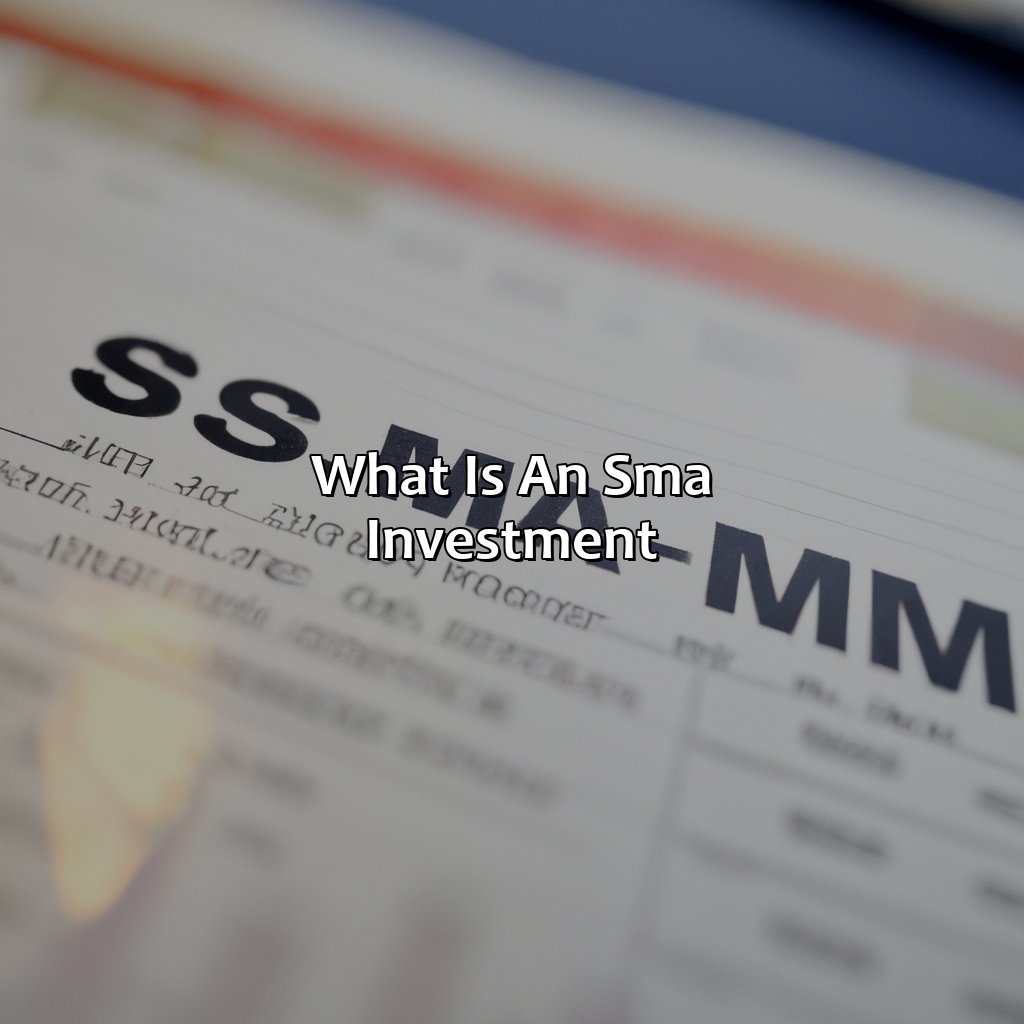What Is An Sma Investment?
Key Takeaway:
- Definition of SMA investment: SMA or Separately Managed Account is a personalized investment account where an investor can tailor their investment portfolio as per their individual preferences. This investment strategy allows investors to hold a particular security or portfolio in their account while managing it through a professional wealth advisor.
- Benefits of investing in SMA: SMAs offer several benefits such as customization, control, tax benefits, transparency, and access to varied investment options. Investors can enjoy personalized investment management, tax minimization, and increased transparency while diversifying their portfolio and minimizing risk.
- Types of SMA investments: There are various types of SMA investments, including equity SMA, fixed-income SMA, multi-manager SMA, and unified managed account (UMA) SMA.
- Factors to consider before investing in SMA: Before investing in SMA, investors should assess their financial goals, investment horizon, risk tolerance, and tax situation. They should also take into account the fees associated with the account and the performance of the professional managing the portfolio.
- How to invest in SMA: Investors can invest in SMA through a professional financial advisor or brokerage firm. They will need to fill out a new account application and provide information on their investment goals and personal financial situation.
- Risks associated with SMA investments: Like any investment, SMA investments carry risks such as market volatility, portfolio management risks, and concentration risks. It’s important to carefully evaluate the risks before investing in an SMA.
- Conclusion: SMA investments can offer a personalized and diversified investment approach for investors seeking greater control over their portfolios. However, it’s important to assess the risks and benefits before making an investment decision.
Are you looking for an investment opportunity that offers potential for higher returns? An SMa investment could be the perfect solution for you. This article will explain what it is and how to get started.
Definition of SMA investment
An SMA investment, also known as Separately Managed Account investment, is a personalized investment portfolio managed by a professional investment manager. The portfolio is tailored to meet the individual investor’s specific investment goals and objectives.
The investment manager has the flexibility to buy and sell individual stocks and bonds, which enables the investor to have a diversified investment portfolio.
SMA investments are popular among high-net-worth individuals seeking greater control, transparency, and customization than mutual funds or exchange-traded funds (ETFs) offer. Investors in SMA accounts are typically charged a fee based on a percentage of their portfolio’s assets under management.
One advantage of investing in SMA accounts is that investors own the individual securities within the portfolio and hold them in their names, which offers greater transparency and tax efficiency. SMA investments also provide greater flexibility than mutual funds or ETFs, as investors can customize their portfolios based on their unique investment objectives, risk tolerance, and other preferences.
A friend of mine, who is a high-net-worth individual, opted for an SMA investment to gain greater control over his investments. He mentioned how it has been a fruitful experience, as he has been able to customize his portfolio according to his preferences, resulting in higher returns. He also noted how the personalized service and transparency provided by the investment manager have helped him make informed investment decisions.
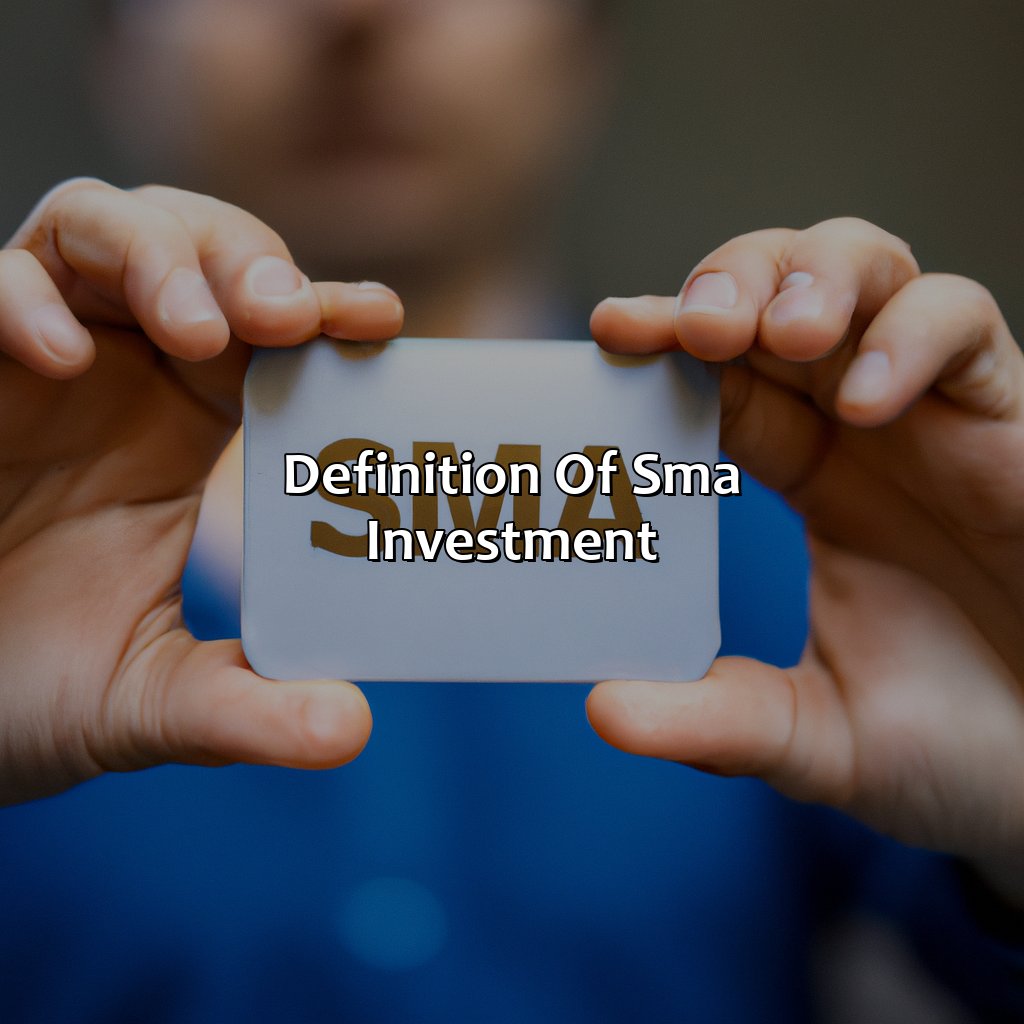
Image credits: retiregenz.com by David Arnold
Benefits of investing in SMA
Investing in an SMA: Maximizing Returns with Greater Control
An SMA investment provides a unique opportunity for investors to customize their portfolio to align with their specific financial goals. Here are three benefits of investing in an SMA:
- Customized Portfolio: With SMA, investors can customize their portfolio to meet their specific goals, including tax optimization and risk tolerance. This flexibility also allows investors to invest in a wide range of asset classes that may not be available in traditional funds, such as private equity and hedge funds.
- Greater Control: With an SMA, investors have greater control over their investments, as they can directly communicate with portfolio managers and make changes to their portfolio without having to go through a fund manager. Moreover, investors can personalize their investment to align with their financial goals and values, as well as take advantage of market opportunities that may arise.
- Transparent Fees: SMA offers a transparent fee structure, enabling investors to track the performance of their portfolio and easily understand their investment costs. Unlike mutual funds, where fees are often hidden, and investors don’t have full transparency, SMA investment fees are typically lower.
Investors can benefit from other advantages, such as access to exclusive investment options, tax efficiency, and reduced transaction costs.
Pro Tip: Before choosing an SMA investment provider, investors should conduct thorough research and due diligence. Investors should evaluate the manager’s performance history, investment philosophy, and client service record. It would be best to work with a registered investment advisor to guide investor decisions.
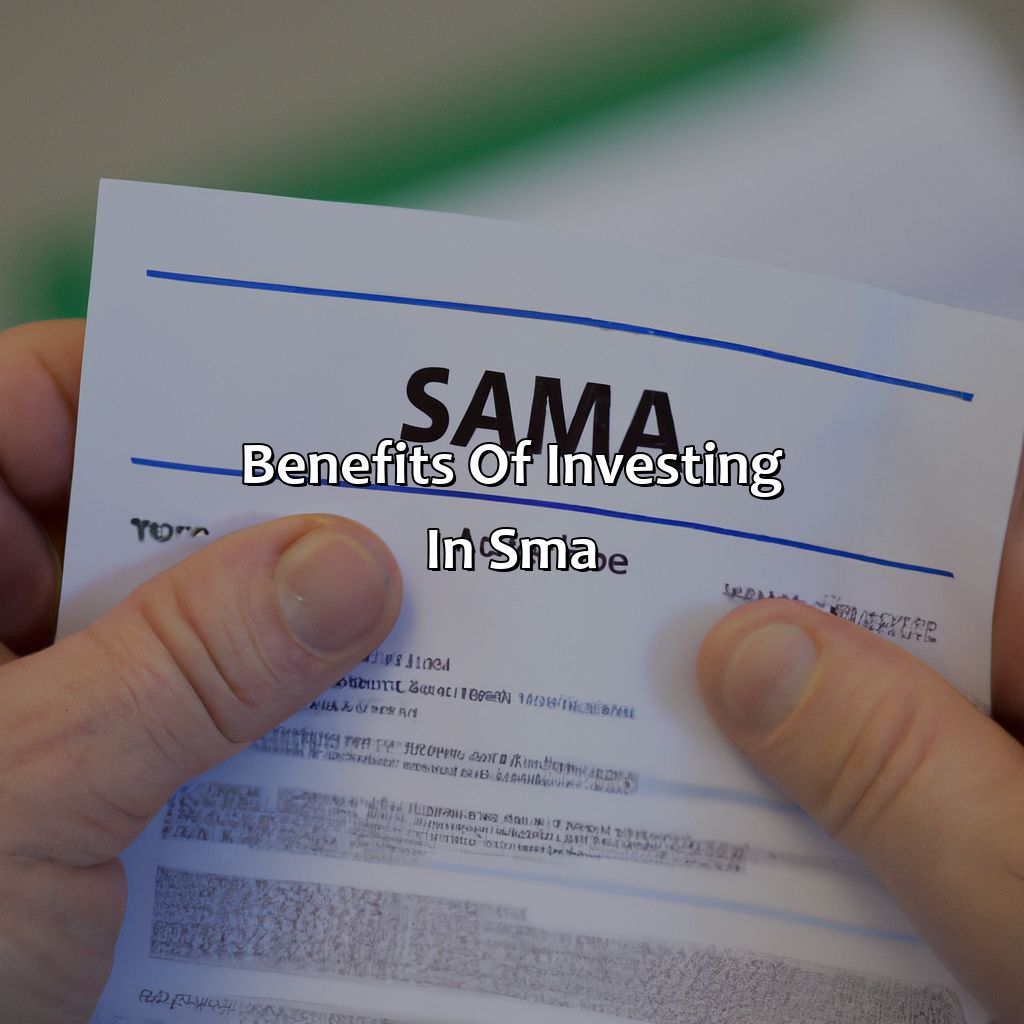
Image credits: retiregenz.com by Joel Woodhock
Types of SMA investments
SMA investments refer to investment vehicles that allow investors to have a personalized portfolio managed by a professional manager. These types of investments are tailored to the specific needs and goals of individual investors.
A table showcasing the types of SMA investments and their respective characteristics would be helpful in understanding the options available. This table could include categories such as Equity, Fixed Income, and Multi-Asset, with columns for Minimum Investment, Management Fees, and Performance Reporting.
It is important to note that while SMA investments do offer a more personalized approach to investing, they may come with higher fees compared to other investment options. One notable detail is that SMA investments are typically only accessible to high net worth individuals. A true history of SMA investments dates back to the 1970s, when institutional investors began to shift away from traditional brokerage services in favor of customized investment portfolios.
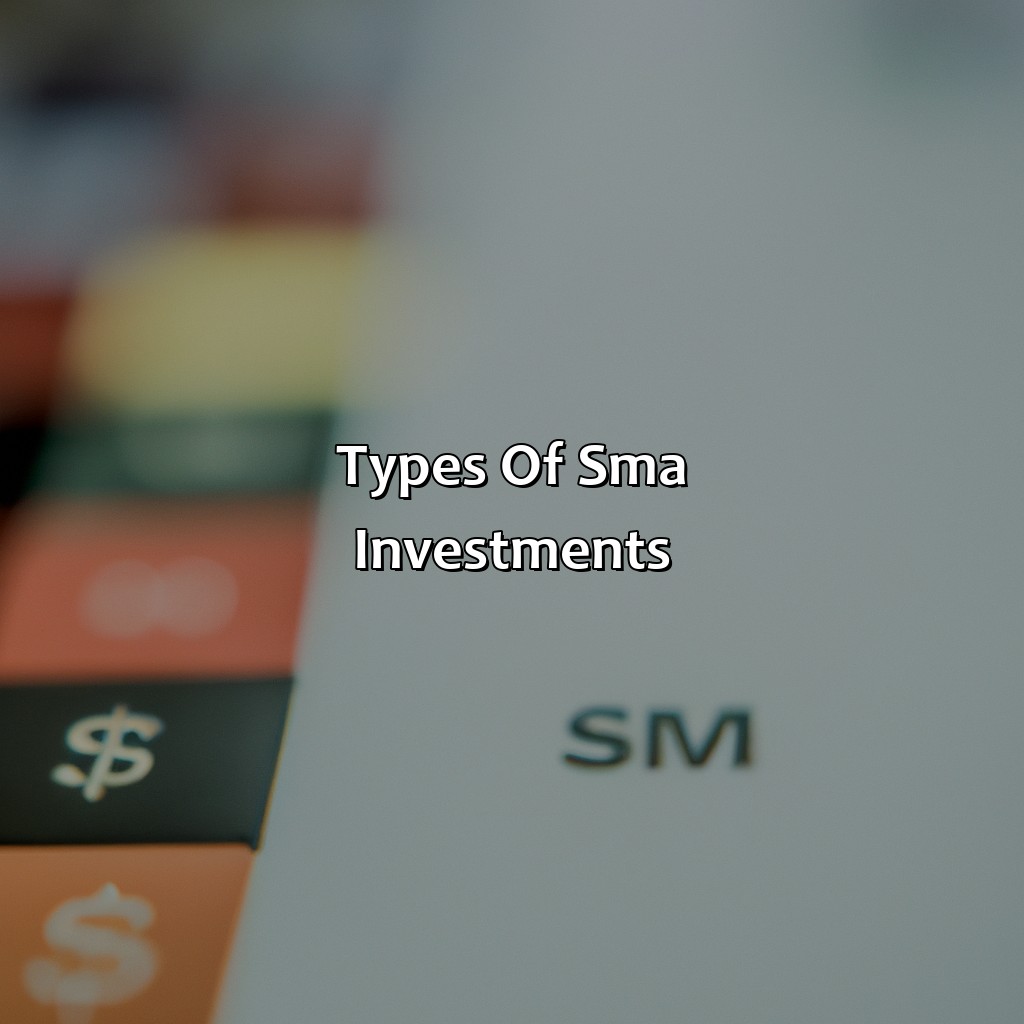
Image credits: retiregenz.com by Adam Duncun
Factors to consider before investing in SMA
Investors should weigh crucial parameters before investing in an SMA. Analyzing investment goals, risk tolerance, cost considerations, portfolio diversification, and tax implications are essential. Conduct thorough research on SMA providers and their investment strategies.
SMA investment vehicles cater to high net worth investors seeking tailored portfolios, typically through separately managed accounts. They provide customization, transparency, and tax efficiency. Their fees and minimum investment requirements are comparatively higher than mutual funds.
Investors must also consider the SMA provider’s investment style, fees, and performance track record. Analyze the portfolio manager’s qualifications and the provider’s risk management processes and technology. Choose providers that meet regulatory standards and follow ethical practices.
According to a Forbes article, SMA structures have registered healthy growth as more investors choose personalization and control over traditional investment products.
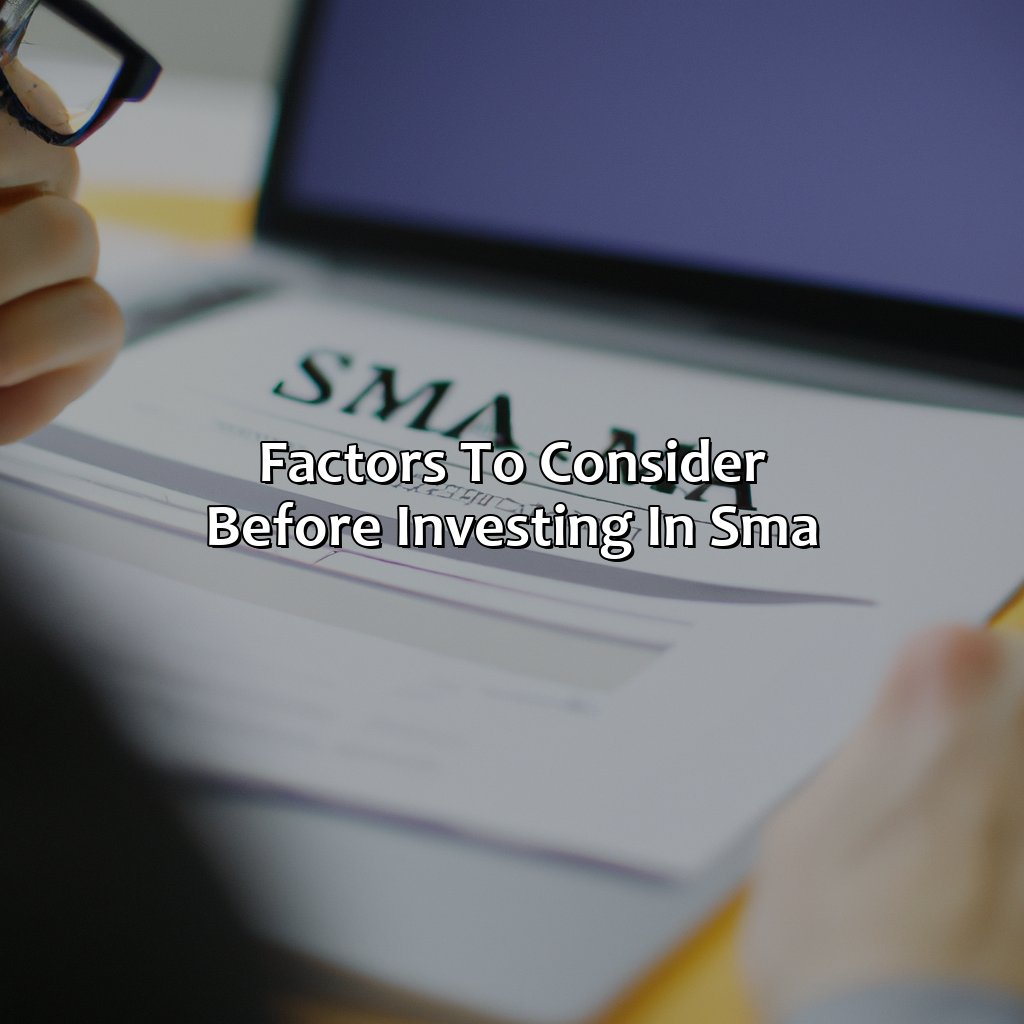
Image credits: retiregenz.com by Adam Jones
How to invest in SMA
Investing in an SMA account requires a proper understanding of the investment vehicle and the steps involved. Here’s a guide on how to invest in an SMA:
- Research SMA providers and choose one that aligns with your investment goals.
- Open an account with the chosen SMA provider, providing all necessary personal and financial information.
- Allocate funds into the account and select a portfolio type.
- The SMA provider will manage the portfolio, buying and selling stocks and bonds that match the chosen portfolio.
- Regularly review the portfolio’s performance and make adjustments as necessary.
- Reinvest dividends and interest earned back into the portfolio.
It’s worth noting that SMA accounts offer numerous benefits, including customization and tax efficiency. However, potential investors should also be aware of the associated fees and the possibility of market risk.
While investing in an SMA can be a wise financial decision, it’s important to keep in mind that every individual’s investment journey is unique. Consider consulting with a financial advisor before making any investment decisions to ensure you are making the best decision for your personal financial situation.
In a similar tone, a young couple invested in an SMA and were able to meet their savings goals for a new home. The ability to customize their portfolio and the tax efficiency of the account made investing in an SMA a top choice for their financial goals.

Image credits: retiregenz.com by James Jones
Risks associated with SMA investments
In managing Separately Managed Accounts, there are several risks that investors should be aware of to make informed decisions.
- One major risk is market volatility, as the value of the assets held in the account may decline due to a variety of factors like political events, natural disasters, and economic downturns.
- Another risk is manager risk, which refers to the potential for underperformance or failure on the part of the account manager. This can lead to subpar returns, and, in the worst-case scenario, the loss of the investors’ capital.
- Moreover, operational risks and exposure to concentrated positions are additional risks that investors should be aware of to mitigate any potential loss.
Investors should carefully assess the risks associated with SMA investments before deciding to participate in them.
Generally, SMA investments require a higher minimum investment capacity, and their fees are higher than mutual funds or exchange-traded funds(ETFs). Despite the high fees, investors may experience the benefits of customization, transparency, and control of their investments. However, investors must also consider the costs of trading, custodial fees, and management fees, which could negatively affect their returns.
It is essential to understand the potential risks and rewards of SMA investments before investing. Investors can seek advice from a financial advisor for a thorough understanding of the risks and customizations available in SMA investments.
Pro Tip – Investors should regularly assess their SMA investments and monitor their performance to ensure that they align with their financial objectives.

Image credits: retiregenz.com by James Washington
Five Facts About SMA Investments:
SMA stands for Separately Managed Account. (Source: Investopedia)
An SMA is a customized investment portfolio managed by a professional manager. (Source: The Balance)
With an SMA investment, the investor retains ownership of the assets being managed. (Source: Schwab)
SMAs generally have higher minimum investment requirements compared to mutual funds and ETFs. (Source: NerdWallet)
SMAs offer greater flexibility and control to investors, with the ability to exclude specific securities or request specific tax treatment. (Source: Forbes)
FAQs about What Is An Sma Investment?
What is an SMA investment?
An SMA investment, or Separately Managed Account, is a type of investment account where an investor’s funds are managed by a professional investment manager. Unlike a mutual fund, an SMA provides individualized portfolio management tailored to the specific needs and preferences of the investor.
How does an SMA investment work?
Investors transfer funds to an investment manager who then creates a customized portfolio for the investor based on their investment objectives, risk tolerance, and other preferences. The investor retains ownership of the individual securities in their portfolio while the manager handles the day-to-day buying and selling of assets.
What are the advantages of an SMA investment?
An SMA investment offers several benefits, including personalized portfolio management, flexibility in investment strategies, and tax efficiency. Additionally, investors have access to the expertise of professional investment managers who can make quick adjustments to their portfolio based on market conditions.
What types of securities can be held in an SMA investment?
Most securities can be included in an SMA investment, including stocks, bonds, ETFs, and mutual funds. The exact makeup of an investor’s portfolio will depend on their investment objectives and risk tolerance, as well as the investment manager’s expertise and strategy.
What is the difference between an SMA and a mutual fund?
While both allow investors to pool their money to invest in a variety of securities, there are some key differences between an SMA and a mutual fund. An SMA is customized to an individual’s investment objectives and risk tolerance, while a mutual fund is a pre-packaged investment product. Also, investors in an SMA own the individual securities in their portfolio, while investors in a mutual fund own shares in the fund itself.
Is an SMA investment suitable for all investors?
An SMA investment is typically best suited for high-net-worth individuals with more complex investment needs and a greater degree of investment experience. The fees for SMA investments can be higher than those for mutual funds or other investment products, so investors should carefully consider their individual needs and preferences before choosing an SMA investment.
 Checkout this IRS Loophole
Checkout this IRS Loophole 
